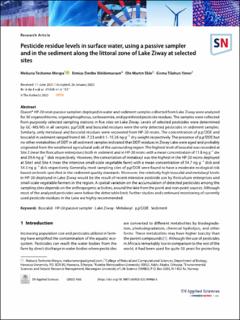| dc.contributor.author | Mergia, Mekuria Teshome | |
| dc.contributor.author | Deribe Weldemariam, Ermias | |
| dc.contributor.author | Eklo, Ole Martin | |
| dc.contributor.author | Ylmer, Girma Tilahun | |
| dc.date.accessioned | 2022-08-11T13:03:42Z | |
| dc.date.available | 2022-08-11T13:03:42Z | |
| dc.date.created | 2022-03-03T10:43:29Z | |
| dc.date.issued | 2022 | |
| dc.identifier.citation | SN Applied Sciences. 2022, 4 . | |
| dc.identifier.issn | 2523-3963 | |
| dc.identifier.uri | https://hdl.handle.net/11250/3011312 | |
| dc.description.abstract | Abstract Diaion® HP-20 resin passive samplers deployed in water and sediment samples collected from Lake Ziway were analyzed for 30 organochlorine, organophosphorus, carboxamide, and pyrethroid pesticide residues. The samples were collected from purposely selected sampling stations in five sites on Lake Ziway. Levels of selected pesticides were determined by GC–MS/MS in all samples. p,p′DDE and boscalid residues were the only detected pesticides in sediment samples. Similarly, only metalaxyl and boscalid residues were recovered from HP-20 resins. The concentration of p,p′DDE and boscalid in sediment ranged from 0.66–7.23 and 0.1–15.26 ng g−1 dry weight respectively. The presence of p,p′DDE but no other metabolites of DDT in all sediment samples indicated that DDT residues in Ziway Lake were aged and probably originated from the weathered agricultural soils of the surrounding region. The highest level of boscalid was recorded at Site 2 (near the floriculture enterprises) both in sediment and in HP-20 resins with a mean concentration of 11.8 ng g−1 dw and 39.6 ng g− 1 disk respectively. However, the concertation of metalaxyl was the highest in the HP-20 resins deployed at Site1 and Site 4 (near the intensive small-scale vegetable farm) with a mean concentration of 54.7 ng g−1 disk and 54.3 ng g− 1 disk respectively. Generally, most sampling sites of p,p′DDE were found to have a moderate ecological risk based on levels specified in the sediment quality standards. Moreover, the relatively high boscalid and metalaxyl levels in HP-20 deployed in Lake Ziway would be the result of recent intensive pesticide use by floriculture enterprises and small-scale vegetable farmers in the region. A spatial variation on the accumulation of detected pesticides among the sampling sites depends on the anthropogenic activities, around the lake from the point and non-point sources. Although most of the analyzed pesticides were below the detectable limit, further studies and continued monitoring of currently used pesticide residues in the Lake are highly recommended. | |
| dc.description.abstract | Pesticide residue levels in surface water, using a passive sampler and in the sediment along the littoral zone of Lake Ziway at selected sites | |
| dc.language.iso | eng | |
| dc.title | Pesticide residue levels in surface water, using a passive sampler and in the sediment along the littoral zone of Lake Ziway at selected sites | |
| dc.title.alternative | Pesticide residue levels in surface water, using a passive sampler and in the sediment along the littoral zone of Lake Ziway at selected sites | |
| dc.type | Peer reviewed | |
| dc.type | Journal article | |
| dc.description.version | publishedVersion | |
| dc.source.pagenumber | 14 | |
| dc.source.volume | 4 | |
| dc.source.journal | SN Applied Sciences | |
| dc.identifier.doi | 10.1007/s42452-022-04966-5 | |
| dc.identifier.cristin | 2007251 | |
| dc.relation.project | NMBU - Norges miljø- og biovitenskapelige universitet: NMBU-HU ICOP –IV | |
| cristin.ispublished | true | |
| cristin.fulltext | original | |
| cristin.qualitycode | 1 | |
